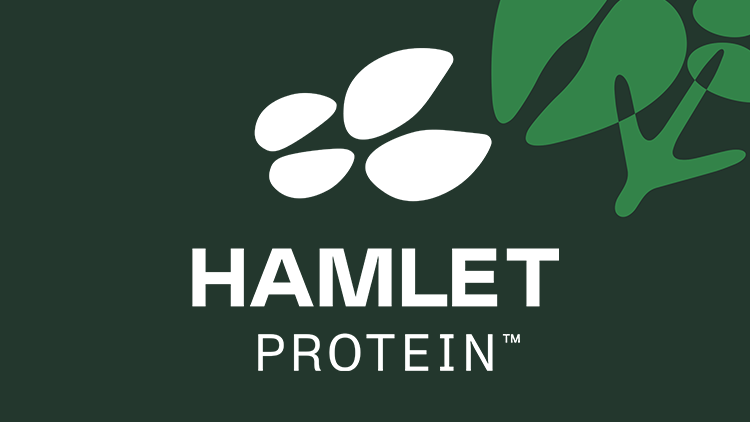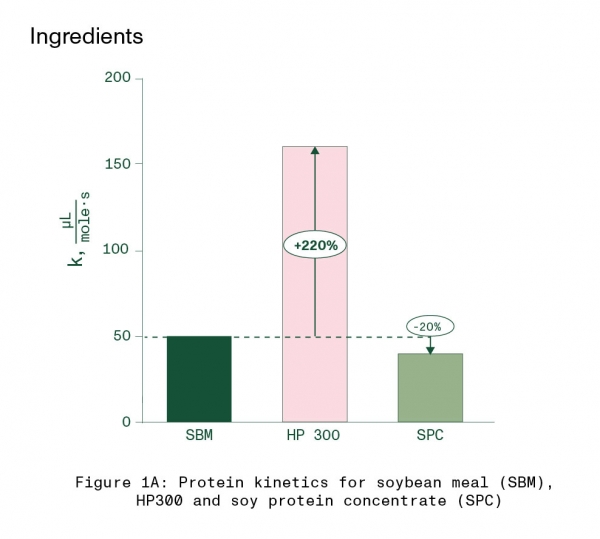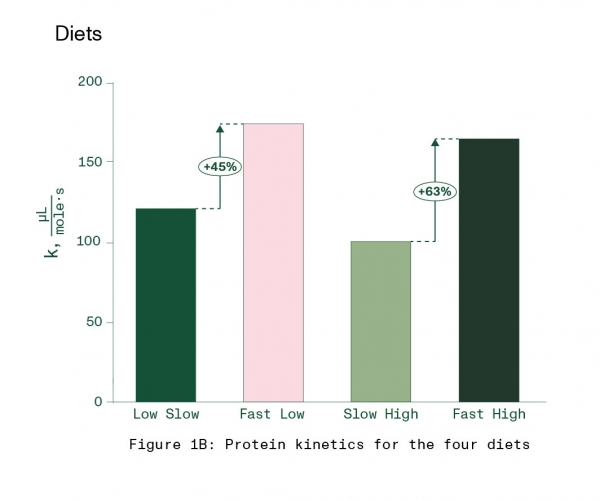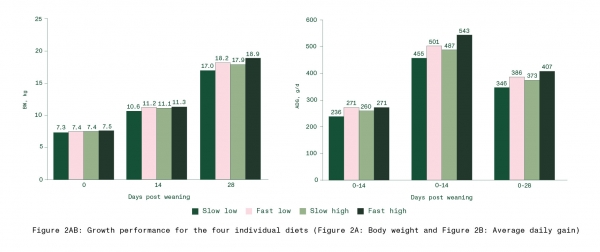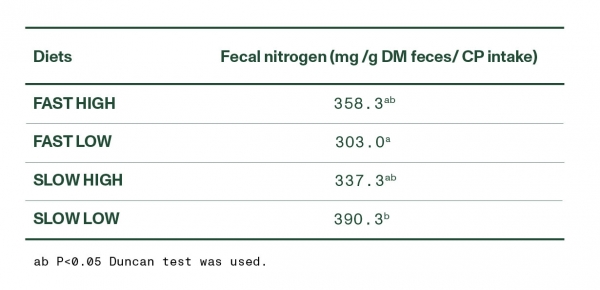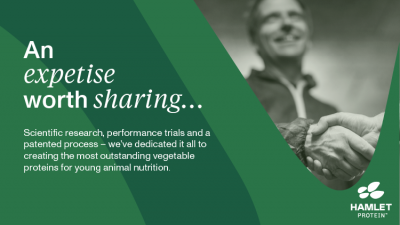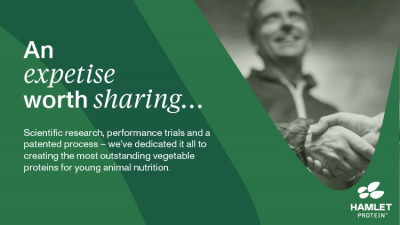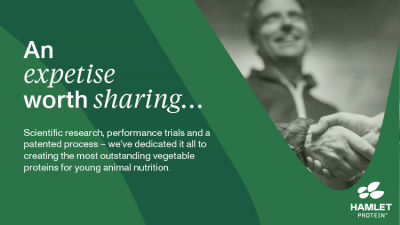Promotional Features
Protein Kinetics: Fast protein in weaned pig diets improves growth and reduces nitrogen excretion
“Hamlet Protein is passionate about driving research on protein digestion, so our customers can be frontrunners in their industry,” says Jessika van Leeuwen, Global Category Manager Swine, Hamlet Protein.
“Therefore, we have spearheaded research into protein kinetics. The latest findings reveal interesting facts about use of fast protein in the diets of weaned pigs. It improves growth performance, overcomes low crude protein levels, and reduces nitrogen excretion,” says van Leeuwen.
Protein kinetics refers to the dynamics between the digestion and absorption of protein and most importantly how fast this happens. The faster a protein source is digested and absorbed, the faster it becomes available for the animals. Recent scientific findings show that the biological value (how much of the protein can be used for deposition) is higher for faster proteins which means less protein is wasted.1 So, faster proteins are also better for the environment as less nitrogen is excreted.
Over the last two years, Hamlet Protein has conducted trials to find out which protein ingredients classify as fast, and which classify as slow. The results of these studies were rather surprising. Some protein ingredients generally considered as highly digestible were rather slow when it came to protein kinetics. The studies also discovered that Hamlet Protein produces the fastest vegetable protein source: HP 300. The results of this research have been published recently at the ASAS-CSAS-WSASAS 2023 meeting in the US.¹
Fast protein from HP 300 results in better weight gain and bodyweight
“To test whether weaned pigs on a diet with fast protein outperformed pigs on a diet with slow protein, we formulated four diets using a differentiating protein source, either HP 300 (fastest vegetable protein) or a soy protein concentrate (SPC), that was previously tested as very slow (Table 1, Figure 1A),” explains van Leeuwen.
The four diets differed in protein source but also in crude protein level (CP) (16 vs 19%), creating Slow-Low, Slow-High, Fast-Low and Fast-High (see Table 1). All diets were supplemented with synthetic amino acids to meet the requirements.
Table 1: Description of the diets
Hamlet Protein found that there was a 45% difference in protein digestion speed between Slow-Low and Fast-Low and a 63% difference in digestion speed between Slow-High and Fast-High which was sufficient to provide digestion speed contrast in the in vivo trial (Figure 1).
Figure 1A: Protein kinetics for soybean meal (SBM), HP 300 and soy protein concentrate (SPC)
Figure 1B: Protein kinetics for the four diets
For the following in vivo test 256 weaned intact male piglets were allocated to one of the four diets based on weight. When analyzing the data after a trial duration of 28 days a strong effect of protein speed was noticeable in the growth performance results. Total weight gain was positively influenced by digestion speed with higher gains for Fast compared to Slow 9 (Table 2). Bodyweight (BW) on D28 was higher for pigs fed Fast diets compared to Slow (Table 2).
Table 2: Growth performance: The use of Fast protein from HP 300 results in better weight gain and BW compared to Slow protein from soy protein concentrate (SPC)
A fast protein source can lower crude protein levels without losing performance
The trial data also shows that the Fast-Low diet numerically outperformed the growth performance of the Slow-high diet (Figure 2A&B). Even at lower protein levels (16% vs 19% CP) the Fast-Low showed higher BW and better average daily gain (ADG). This means that using a fast protein source one can lower CP levels without losing performance, which can relate to a better synchronization in absorption with the supplemented synthetic amino acids in the diet.
Figure 2AB: Growth performance for the four individual diets (Figure 2A: Body weight and Figure 2B: Average daily gain)
Fast protein is better utilized resulting in lower nitrogen excretion
A 2022 study showed that the better the synchronization in absorption of total amino acids the higher the nitrogen deposition rate and the higher the apparent biological value of the protein source.2 This indicates that faster protein is better utilized than slow protein. This was confirmed by lower nitrogen levels in faeces for Fast diets. Average nitrogen levels in faeces from D14-28 tended to be lower for fast compared to slow (Table 3).
Table 3: Nitrogen excretion in faeces (mg/g dry matter faeces/CP intake)
So, from fast protein less nitrogen is wasted. Therefore, protein kinetics are more indicative of feed efficiency and protein deposition than the digestibility coefficient of the protein ingredient.
Pigs on fast protein showed better growth performance than pigs on slow protein. The use of fast protein allows for the reduction of CP levels without losing performance. This argues in favor of a better protein efficiency for fast protein – a finding that was supported by lower nitrogen excretions.
“It is therefore safe to say that not only (young) animals have a requirement for fast protein from a physiological point of view, but also nutritionists have a requirement to provide fast protein in order to optimize the use of synthetic amino acids in diets and to meet the requirements regarding total nitrogen excretion reduction,” van Leeuwen concludes.
Vegetal plasma
The findings of this study conclude that (young) animals have a requirement for fast protein as this enables them to use more of the protein for deposition. Furthermore, when supplementing diets with synthetic amino acids, the absorption of all the amino acids from the diet needs to be synchronized with these synthetic amino acids without losing efficiency. A fast protein source allows for good synchronization in the absorption of amino acids.
Studies of a variety of protein sources found that Hamlet Protein produces the fastest vegetable protein source which is also almost free of the most important anti-nutritional factors. The Hamlet Protein portfolio is a high-performing vegetal protein source when it comes to kinetics and is also on par with the animal proteins, like fish meal and blood plasma. Hamlet Protein therefore proposes a new positioning and reappreciation of its flagship product HP 300 as the only vegetal plasma currently on the market.
References
1. Bible, et al. (2023). In-vitro evaluation of protein kinetics of soy-based ingredients. Proceedings ASAS CSAS WASAS.
2. Zhang, Q.; Wang, B.; Hu, N.; et al. (2022). Relationship between dietary amino acid release kinetics and nitrogen deposition in growing pigs. Animal nutrition (Zhongguo xu mu shou yi xue hui), 9, 233–239.

